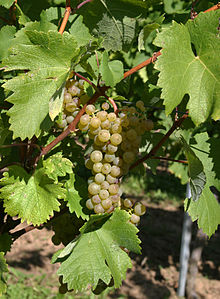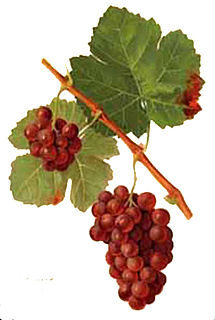
Gewürztraminer is an aromatic wine grape variety, used in white wines, and performs best in cooler climates. In English, it is sometimes referred to colloquially as Gewürz, and in English and French it is written Gewurztraminer. Gewürztraminer is a variety with a pink to red skin colour, which makes it a "white wine grape" as opposed to the blue to black-skinned varieties commonly referred to as "red wine grapes". The variety has high natural sugar and the wines are white and usually off-dry, with a flamboyant bouquet of lychees. Indeed, Gewürztraminer and lychees share the same aroma compounds. Dry Gewürztraminers may also have aromas of roses, passion fruit and floral notes. It is not uncommon to notice some spritz.

Dornfelder is a dark-skinned variety of grape of German origin used for red wine. It was created by August Herold (1902–1973) at the grape breeding institute in Weinsberg in the Württemberg region in 1955. Herold crossed the grape varieties Helfensteiner and Heroldrebe, the latter which bears his name, to create Dornfelder. Helfensteiner and Heroldrebe were both crosses created some decades earlier by Herold. Dornfelder received varietal protection and was released for cultivation in 1979. It was named in honor of Immanuel August Ludwig Dornfeld (1796–1869), a senior civil servant who was instrumental in creating the viticultural school in Weinsberg.
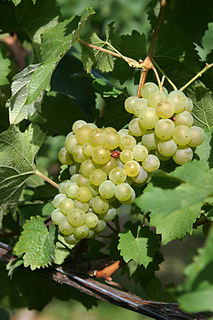
Bacchus is a white wine grape created by viticulturalist Peter Morio at the Geilweilerhof Institute for Grape Breeding in the Palatinate in 1933. He crossed a Silvaner x Riesling cross with Müller-Thurgau.

Scheurebe or Sämling 88 is a white wine grape variety. It is primarily grown in Germany and Austria, where it often is called Sämling 88, and some parts of the New World. Scheurebe wines are highly aromatic, and the variety is often used for sweet wines, although dry Scheurebe wines have become more common in Germany.
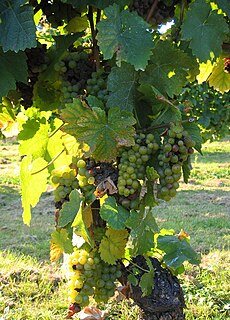
Morio Muscat is a white wine grape that was created by viticulturalist Peter Morio at the Geilweilerhof Institute for Grape Breeding in the Palatinate in 1928. He claimed to have crossed the varieties Silvaner and Pinot blanc, but based on the variety's properties it has been speculated that he actually crossed Silvaner and Muscat Blanc à Petits Grains. But so far this speculation has yet to be conclusively proven. The grape is highly aromatic with a "grapey" characteristic reminiscent of Muscat grape varieties. The grape is rarely used for varietal wines because it requires a high level of ripeness to avoid producing wine with a "mousey" flavor, a coarse texture and overabundance of acidity.

Siegerrebe is a white wine grape that is grown primarily in Germany with some plantings in England, Vancouver Island, Washington state, British Columbia's North Okanagan and Fraser Valley and Nova Scotia's Annapolis Valley. Siegerrebe was created by German viticulturalist Dr. Georg Scheu (1879-1949) in 1929 at a grape-breeding institute in Alzey in Rheinhessen, by crossing Madeleine Angevine and Gewürztraminer. However, Georg Scheu's son Heinz Scheu has claimed in a book that Siegerrebe was the result of self-pollination of Madeleine Angevine. Siegerrebe received varietal protection and was released for general cultivation in Germany in 1958.

Palatinate is a German wine-growing region (Weinbaugebiet) in the area of Bad Dürkheim, Neustadt an der Weinstraße, and Landau in Rhineland-Palatinate. Before 1993, it was known as Rhine Palatinate (Rheinpfalz). With 23,461 hectares under cultivation in 2008, the region is the second largest wine region in Germany after Rheinhessen. There are about 6,800 vintners producing around 6.5 million hectolitres of wine annually.

The Kerner grape is an aromatic white grape variety. It was bred in 1929 by August Herold by crossing Trollinger and Riesling. Herold was working at a plant breeding station in Lauffen in the Württemberg region of Germany. This station belonged to a state breeding institute headquartered in Weinsberg. It received varietal protection and was released for general cultivation in 1969.

The Hessische Bergstraße is a defined region (Anbaugebiet) for wine in Germany located in the state of Hesse among the northern and western slopes of the Odenwald mountain chain. With only 467 hectares of vineyards it is the smallest of the 13 German quality wine regions. At 21% red grape varieties and 79% white varieties, it is planted with primarily Riesling, Pinot gris (12%) and Spätburgunder. Hessische Bergstraße is divided into two districts (Bereiche) - Umstadt and Starkenburg - three collective vineyard sites and 24 individual vineyard sites.

Solaris is a variety of grape used for white wine. It was created in 1975 at the grape breeding institute in Freiburg, Germany by Norbert Becker.

Faberrebe or Faber is a grape variety used for white wine. It was created in 1929 by Georg Scheu at the Landesanstalt für Rebenzüchtung in Alzey and was released with varietal protection in 1967. Scheu created Faberrebe by crossing Pinot blanc and Müller-Thurgau.

Domina is a dark-skinned variety of grape used for red wine. It was created by German viticulturalist Peter Morio at the Geilweilerhof Institute for Grape Breeding in the Palatinate in 1927 by crossing the varieties Blauer Portugieser and Pinot noir.

Dunkelfelder is a dark-skinned variety of grape used for red wine. It was created by German viticulturalist Gustav Adolf Froelich (1847-1912). He probably crossed Färbertraube with Blauer Portugieser. The variety, initially called Froelich V 4-4, did not receive any attention for several decades until work was continued on it at Geisenheim grape breeding institute in the 1930s. It was named Dunkelfelder by ampelographer Helmut Becker, due to its unclear parentage and its dark colour. Dunkelfelder received varietal protection and was released for general cultivation in 1980.
Optima is a white wine grape that was created by viticulturalist Peter Morio at the Geilweilerhof Institute for Grape Breeding in the Palatinate in 1930. Morio crossed a Riesling x Silvaner cross with Müller-Thurgau. The Riesling x Silvaner is sometimes mentioned as Rieslaner, but more often just as "a Riesling x Silvaner". Due to the random element of genetic recombination involved in sexual reproduction of plants, no two crosses of the same parent grape varieties will be identical, so there is a difference between the Riesling x Silvaner cross Rieslaner, and each other such cross.
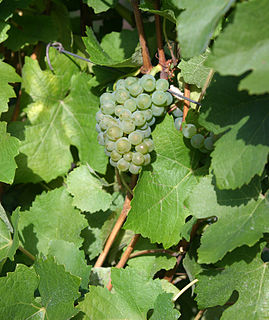
Freisamer is a white German wine grape variety grown primarily in the Baden region with some plantings in eastern and western Switzerland. The variety was created in 1916 by Karl Müller at the Staatliches Weinbauinstitut in Freiburg im Breisgau, Germany by crossing Pinot gris and Silvaner. The purpose of the crossing was to find an improved variety similar to Pinot gris. The name is a contraction of Freiburg and Dreisam, the river that runs through Freiburg.
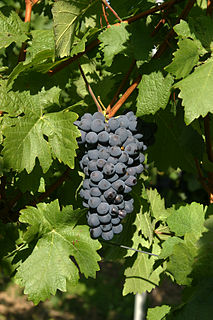
Helfensteiner is a dark-skinned German wine grape crossing of the species Vitis vinifera, that was created in 1931 with the crossing of Frühburgunder and Trollinger. It was created by August Herold at the grape breeding institute in Weinsberg in the Württemberg region.

Heroldrebe is a red German wine grape variety produced by crossing Blauer Portugieser and Lemberger. It was created by August Herold at the grape breeding institute in Weinsberg in the Württemberg region in 1929, and was named after him.
Phoenix is a white variety of grape of German origin used for wine. It was created by Dr. Gerhardt Alleweldt (1927–2005) at the Geilweilerhof Institute for Grape Breeding in Siebeldingen in 1964, by crossing the Vitis vinifera variety Bacchus with the hybrid grape Villard Blanc.
Regner is a white German wine grape variety that is a crossing of the table grape Seidentraube and the Vitis vinifera red grape variety Gamay. The variety was developed in 1929 and by 2019 there was almost 12 hectares of Regner planted in Germany, all in the Rheinhessen. By the late 20th century, wine growers in England were also experimenting with the variety.
Georg Scheu, was a German botanist, plant physiologist, oenologist and grape breeder.
